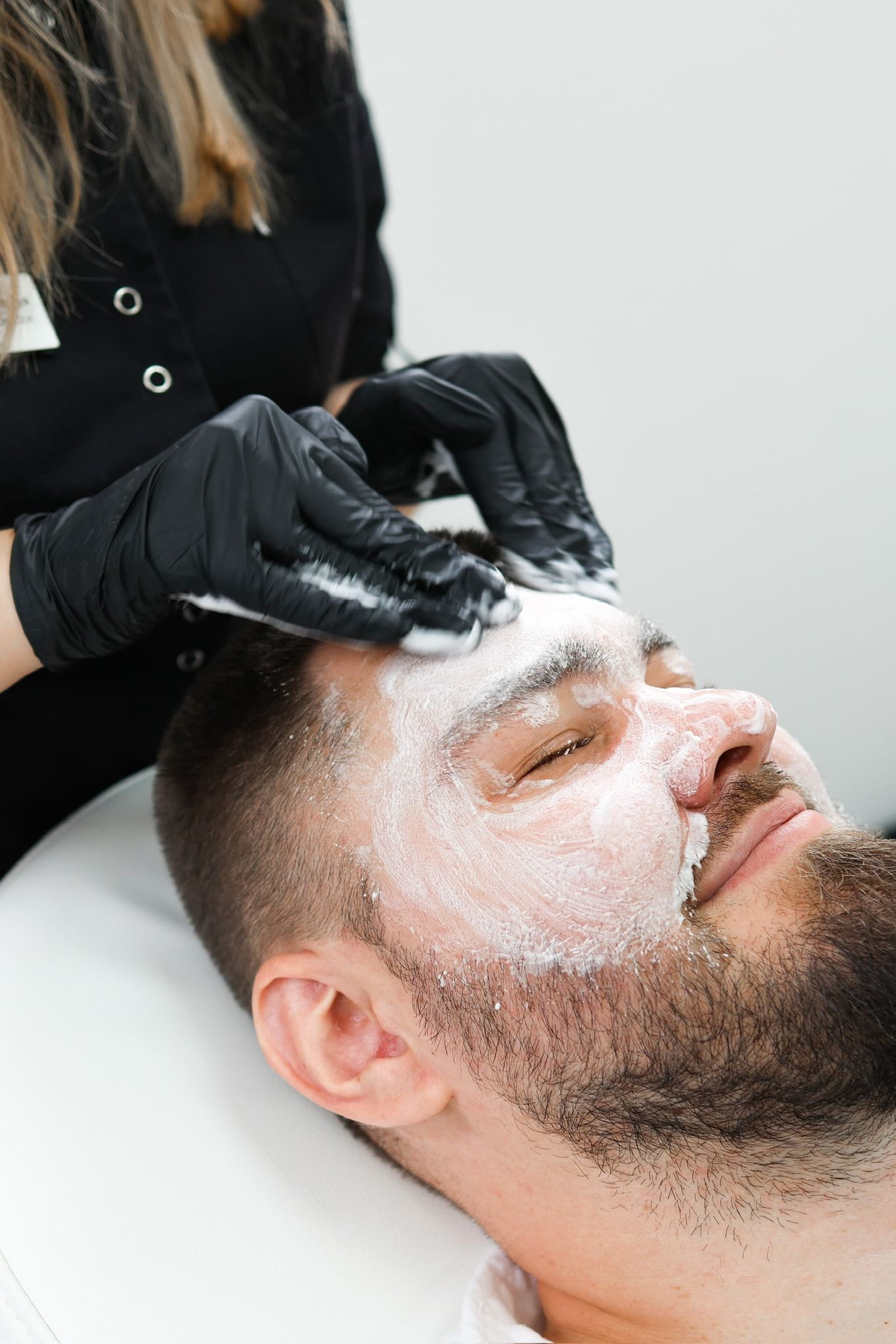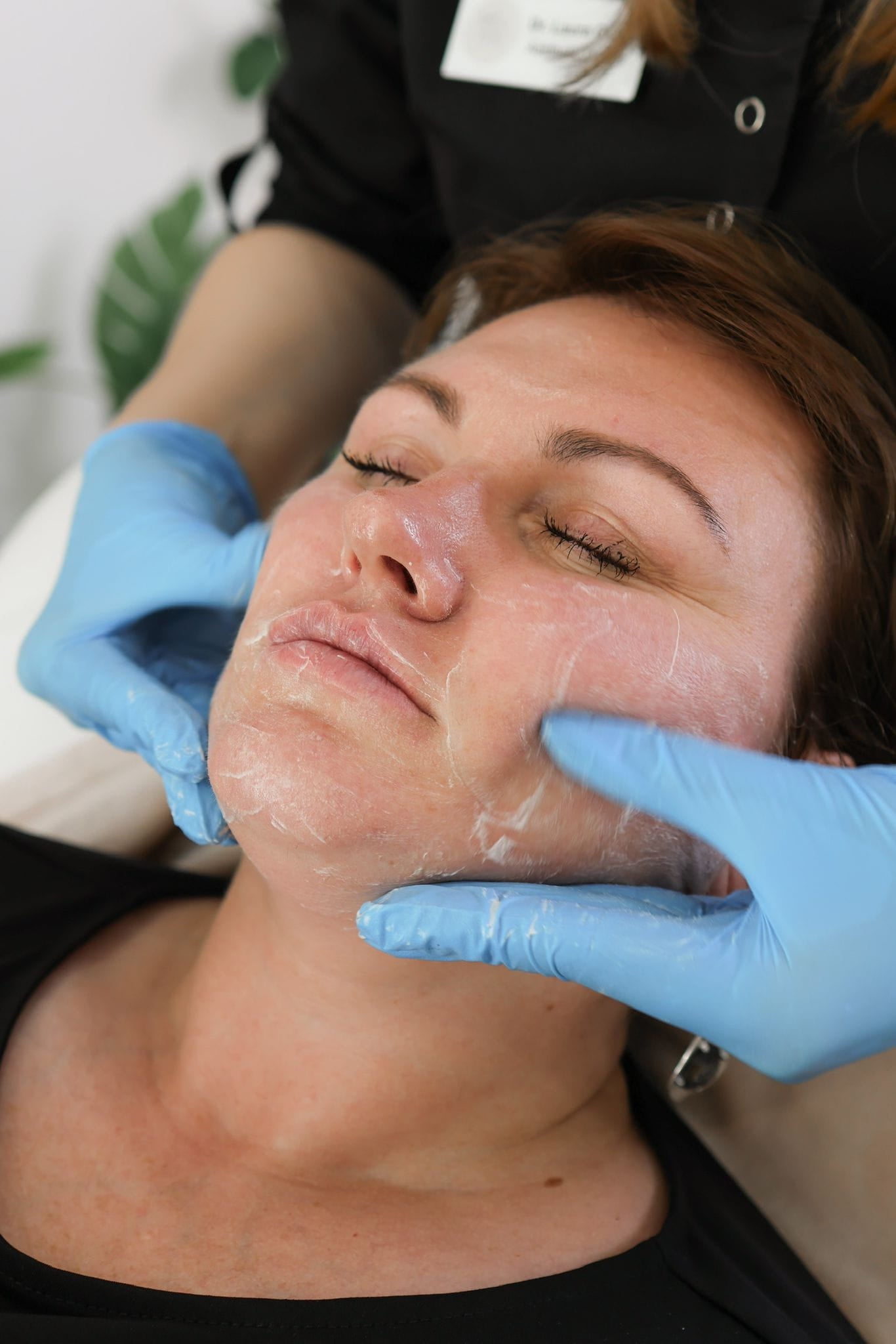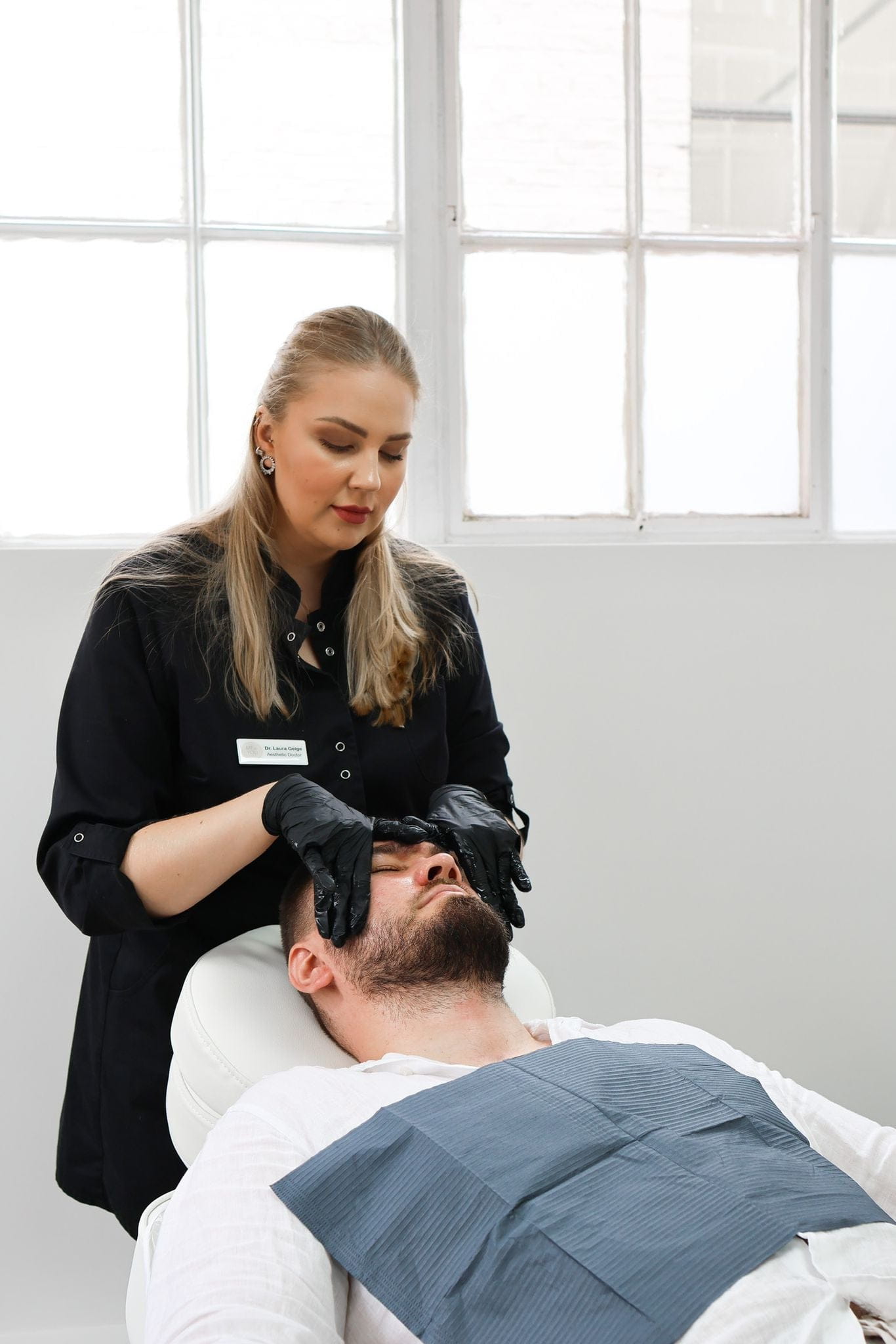Cosmelan Depigmentation Peel
When it comes to tackling hyperpigmentation and achieving an even skin tone, two popular options stand out: Cosmelan Depigmentation Peel and laser treatments. Both offer promising results but come with different approaches and considerations.
What is Cosmelan?
Cosmelan is a professional-grade chemical peel specifically designed for treating various pigmentation issues such as melasma, age spots, sunspots, and post-inflammatory hyperpigmentation. It utilizes a unique blend of ingredients that work synergistically to inhibit melanin production, lighten existing pigment, and prevent further darkening.
How Does Cosmelan Work?
Cosmelan works by targeting the melanocytes, cells responsible for producing melanin, the pigment that gives skin its color. The peel contains a potent cocktail of antioxidants, inhibitors, and exfoliating agents which penetrate deep into the skin’s layers. This complex formulation disrupts the melanin production process, effectively reducing the appearance of pigmentation.
The treatment also promotes cell turnover, shedding off the outer layer of dead skin cells to reveal brighter, more even-toned skin underneath. Cosmelan is a multi-step process involving a professional application and subsequent maintenance products used at home, ensuring long-lasting results.
Benefits of Cosmelan
One of the main benefits of Cosmelan is its effectiveness in addressing a wide range of pigmentation concerns. It can target various types of hyperpigmentation, including melasma, which is often resistant to other treatments.
Another advantage is that it provides noticeable results within a relatively short timeframe. Many individuals see improvements in their skin tone after just a few weeks of treatment.
Cosmelan is also known for its long-lasting effects. When used consistently with the recommended home maintenance products, the results can persist for months or even years.

Additionally, Cosmelan offers the benefit of being a non-invasive treatment. Unlike laser treatments, it does not involve any surgical procedures or extensive downtime.
Risks and Side Effects
Despite its benefits, Cosmelan Depigmentation Peel can have certain risks and side effects. Common side effects include redness, peeling, itching, and sensitivity to sunlight. These typically subside within a few days to weeks after treatment.
In some cases, individuals may experience more severe reactions such as hyperpigmentation (darkening of the skin), hypopigmentation (lightening of the skin), or allergic reactions. It’s crucial to consult with a qualified dermatologist before undergoing any chemical peel treatment to assess your suitability and minimize potential risks.
Proper aftercare is essential for minimizing side effects and maximizing results. This includes avoiding sun exposure, using sunscreen diligently, and following the dermatologist’s instructions for home maintenance products.
Laser Treatments for Pigmentation
When it comes to tackling hyperpigmentation and achieving an even skin tone, two popular options stand out: Cosmelan Depigmentation Peel and laser treatments. Both offer promising results but come with different approaches and considerations.
Types of Laser Treatments
Laser treatments for pigmentation utilize different types of lasers that target melanin, the pigment responsible for skin color.
One common type is the Q-switched Nd:YAG laser, which emits short bursts of high-energy light to break down melanin in pigmented areas. Another option is the Intense Pulsed Light (IPL) therapy, which uses a broad spectrum of light to target multiple pigmentation concerns.
Fractional lasers are another type used for pigmentation treatment. They work by creating tiny micro-injuries in the skin, stimulating collagen production and promoting cell turnover to improve skin texture and reduce pigmentation.
Fractional Lasers
Fractional lasers are a relatively newer technology in the field of dermatology and have gained significant popularity for treating various skin concerns, including hyperpigmentation. These lasers work by delivering focused beams of light that create tiny columns or micro-injuries in the skin’s surface while leaving the surrounding tissue intact.
This unique mechanism allows for controlled damage and accelerated healing, minimizing downtime compared to traditional ablative laser treatments.
The micro-injuries stimulate the body’s natural repair processes, triggering the production of collagen and elastin, proteins responsible for skin firmness and elasticity.
This increased collagen production helps improve skin texture, reduce fine lines and wrinkles, and even out pigmentation by promoting cell turnover and shedding off pigmented cells.
Fractional lasers are effective in addressing a range of pigmentation issues, including sunspots, age spots, melasma, and post-inflammatory hyperpigmentation. They can also improve the appearance of acne scars and other skin imperfections.
Q-Switched Lasers
Laser treatments for pigmentation utilize different types of lasers that target melanin, the pigment responsible for skin color.
One common type is the Q-switched Nd:YAG laser, which emits short bursts of high-energy light to break down melanin in pigmented areas. Another option is the Intense Pulsed Light (IPL) therapy, which uses a broad spectrum of light to target multiple pigmentation concerns.
- Q-Switched Nd:YAG lasers
- Intense Pulsed Light (IPL)
Fractional lasers are another type used for pigmentation treatment. They work by creating tiny micro-injuries in the skin, stimulating collagen production and promoting cell turnover to improve skin texture and reduce pigmentation.
Fractional lasers are a relatively newer technology in the field of dermatology and have gained significant popularity for treating various skin concerns, including hyperpigmentation. These lasers work by delivering focused beams of light that create tiny columns or micro-injuries in the skin’s surface while leaving the surrounding tissue intact.
This unique mechanism allows for controlled damage and accelerated healing, minimizing downtime compared to traditional ablative laser treatments.
The micro-injuries stimulate the body’s natural repair processes, triggering the production of collagen and elastin, proteins responsible for skin firmness and elasticity.
How Laser Treatments Work
Laser treatments for pigmentation utilize different types of lasers that target melanin, the pigment responsible for skin color.

One common type is the Q-switched Nd:YAG laser, which emits short bursts of high-energy light to break down melanin in pigmented areas. Another option is the Intense Pulsed Light (IPL) therapy, which uses a broad spectrum of light to target multiple pigmentation concerns.
Fractional lasers are another type used for pigmentation treatment. They work by creating tiny micro-injuries in the skin, stimulating collagen production and promoting cell turnover to improve skin texture and reduce pigmentation.
Benefits of Laser Treatment
Laser treatments for pigmentation utilize different types of lasers that target melanin, the pigment responsible for skin color.
One common type is the Q-switched Nd:YAG laser, which emits short bursts of high-energy light to break down melanin in pigmented areas. Another option is the Intense Pulsed Light (IPL) therapy, which uses a broad spectrum of light to target multiple pigmentation concerns.
- Q-Switched Nd:YAG lasers
- Intense Pulsed Light (IPL)
Fractional lasers are another type used for pigmentation treatment. They work by creating tiny micro-injuries in the skin, stimulating collagen production and promoting cell turnover to improve skin texture and reduce pigmentation.
One of the main advantages of laser treatments is their precision. They can target specific areas of hyperpigmentation without affecting surrounding healthy skin.
Laser treatments are also often more effective than other methods at addressing deeper pigmentation issues that may be resistant to topical creams or chemical peels.
Another benefit is the relatively quick treatment time. Most laser sessions take only a few minutes to complete, and downtime is typically minimal.
However, laser treatments can have some potential downsides. They may cause temporary redness, swelling, or discomfort after the procedure.
It’s important to follow your dermatologist’s instructions carefully for pre- and post-treatment care to minimize risks and ensure optimal results.
Risks and Side Effects
Laser treatments for pigmentation utilize different types of lasers that target melanin, the pigment responsible for skin color.
One common type is the Q-switched Nd:YAG laser, which emits short bursts of high-energy light to break down melanin in pigmented areas. Another option is the Intense Pulsed Light (IPL) therapy, which uses a broad spectrum of light to target multiple pigmentation concerns.
- Q-Switched Nd:YAG lasers
- Intense Pulsed Light (IPL)
Fractional lasers are another type used for pigmentation treatment. They work by creating tiny micro-injuries in the skin, stimulating collagen production and promoting cell turnover to improve skin texture and reduce pigmentation.
One of the main benefits of laser treatments is their precision. They can target specific areas of hyperpigmentation without affecting surrounding healthy skin.
Laser treatments are also often more effective than other methods at addressing deeper pigmentation issues that may be resistant to topical creams or chemical peels.
Another benefit is the relatively quick treatment time. Most laser sessions take only a few minutes to complete, and downtime is typically minimal.
However, laser treatments can have some potential downsides. They may cause temporary redness, swelling, or discomfort after the procedure.
It’s important to follow your dermatologist’s instructions carefully for pre- and post-treatment care to minimize risks and ensure optimal results.
Comparison: Cosmelan vs. Laser Treatments
When it comes to tackling hyperpigmentation and achieving an even skin tone, two popular options stand out: Cosmelan Depigmentation Peel and laser treatments. Both offer promising results but come with different approaches and considerations.
Effectiveness
Choosing between Cosmelan Depigmentation Peel and laser treatments for pigmentation depends on individual needs and preferences.
Cosmelan is a suitable option for those seeking a multi-step chemical peel to address various types of hyperpigmentation, including melasma. Its effectiveness in targeting diverse pigmentation concerns and its long-lasting results make it a popular choice. However, potential side effects like redness and sensitivity should be considered.
Laser treatments, on the other hand, are favored for their precision and ability to target deeper pigmentation issues. They offer relatively quick treatment times and minimal downtime. The different types of lasers cater to specific pigmentation concerns, allowing for customized treatment plans.
Consulting with a qualified dermatologist is crucial to determine the most suitable option based on your skin type, pigmentation concerns, and individual needs. They can assess your skin and recommend the best course of action for achieving optimal results.
Cost and Duration of Treatment
When it comes to tackling hyperpigmentation and achieving an even skin tone, two popular options stand out: Cosmelan Depigmentation Peel and laser treatments. Both offer promising results but come with different approaches and considerations.
Choosing between Cosmelan Depigmentation Peel and laser treatments for pigmentation depends on individual needs and preferences.
- Cosmelan is a suitable option for those seeking a multi-step chemical peel to address various types of hyperpigmentation, including melasma. Its effectiveness in targeting diverse pigmentation concerns and its long-lasting results make it a popular choice. However, potential side effects like redness and sensitivity should be considered.
- Laser treatments, on the other hand, are favored for their precision and ability to target deeper pigmentation issues. They offer relatively quick treatment times and minimal downtime. The different types of lasers cater to specific pigmentation concerns, allowing for customized treatment plans.
Consulting with a qualified dermatologist is crucial to determine the most suitable option based on your skin type, pigmentation concerns, and individual needs. They can assess your skin and recommend the best course of action for achieving optimal results.
Cosmelan Depigmentation Peel and laser treatments both aim to reduce hyperpigmentation but differ in their mechanisms and suitability for different skin types and conditions.
To make an informed decision, it’s essential to consult with a dermatologist who can evaluate your specific needs and recommend the most appropriate treatment option.
- Cosmelan is typically less expensive than laser treatments, especially when considering multiple sessions.
- Laser treatments generally cost more per session but may require fewer treatments overall.
The duration of treatment also varies depending on the chosen method:
- Cosmelan: A series of professional applications and ongoing home maintenance are typically required, with noticeable results usually appearing within a few weeks and lasting for months to years.
- Laser treatments: Multiple sessions spaced several weeks apart may be needed to achieve desired results. Downtime varies depending on the type of laser used.
Downtime and Recovery

Both Cosmelan and laser treatments offer effective solutions for pigmentation issues, but their approaches differ.
Cosmelan is a chemical peel that uses a blend of ingredients to inhibit melanin production, lighten existing pigment, and prevent further darkening. It typically involves multiple professional applications followed by home maintenance products.
Laser treatments target melanin directly using different types of lasers (Q-switched Nd:YAG, IPL, or fractional lasers). They work by breaking down melanin or stimulating collagen production for improved skin texture.
Cosmelan is generally less expensive but requires a multi-step process and ongoing commitment to home care. Laser treatments are often more expensive per session but can be quicker with potentially less downtime. The best choice depends on individual needs, budget, and the specific pigmentation concern being addressed. Consulting with a dermatologist is crucial for determining the most suitable option and achieving optimal results.
Suitability for Different Skin Types
Cosmelan and laser treatments are both popular choices for addressing hyperpigmentation, but they work in different ways and are suitable for varying skin types.
Cosmelan is a chemical peel that uses a blend of ingredients to inhibit melanin production, lighten existing pigment, and prevent further darkening. It’s particularly effective for melasma, sunspots, age spots, and post-inflammatory hyperpigmentation. Cosmelan works best on individuals with Fitzpatrick Skin Types I to IV and can be a good option for those seeking long-lasting results with minimal downtime. However, potential side effects like redness and sensitivity should be considered.
Laser treatments, on the other hand, target melanin directly using various types of lasers (Q-switched Nd:YAG, IPL, or fractional). They break down melanin or stimulate collagen production for improved skin texture and even tone. Laser treatments are effective for a range of pigmentation issues and can address deeper pigment concerns better than topical treatments. They are generally suitable for most Fitzpatrick Skin Types but may require more sessions and have potential side effects like temporary redness and discomfort.
**Here’s a breakdown to help determine which might be best for you:**
* **Cosmelan:**
* **Best for:** Melasma, sunspots, age spots, post-inflammatory hyperpigmentation.
* **Skin types:** Fitzpatrick I-IV.
* **Benefits:** Long-lasting results, minimal downtime.
* **Considerations:** Potential side effects (redness, sensitivity), requires ongoing home care.
* **Laser Treatments:**
* **Best for:** A variety of pigmentation concerns, including deeper pigment issues.
* **Skin types:** Most Fitzpatrick skin types.
* **Benefits:** Precision targeting, quick treatment times, potential for long-lasting results.
* **Considerations:** Higher cost per session, potential side effects (redness, discomfort), may require multiple sessions.
Ultimately, the best choice depends on your individual needs and concerns. Consulting with a qualified dermatologist is crucial to determine the most suitable option and create a personalized treatment plan for achieving your desired results.
Conclusion
In conclusion, both Cosmelan Depigmentation Peel and laser treatments offer effective solutions for reducing hyperpigmentation and achieving an even skin tone. Cosmelan is a chemical peel that provides long-lasting results by inhibiting melanin production, while laser treatments target pigment directly using various types of lasers.
The best choice depends on individual factors such as skin type, budget, desired outcome, and personal preference. Consulting with a qualified dermatologist is crucial to determine the most suitable option based on your specific needs and ensure optimal results.
- How Neck Line Fillers Rejuvenate The Skin Around The Neck In Surrey - August 20, 2025
- How Much Is Lip Filler Injections - August 19, 2025
- How Many Days After Lip Filler Can You Kiss - August 14, 2025
